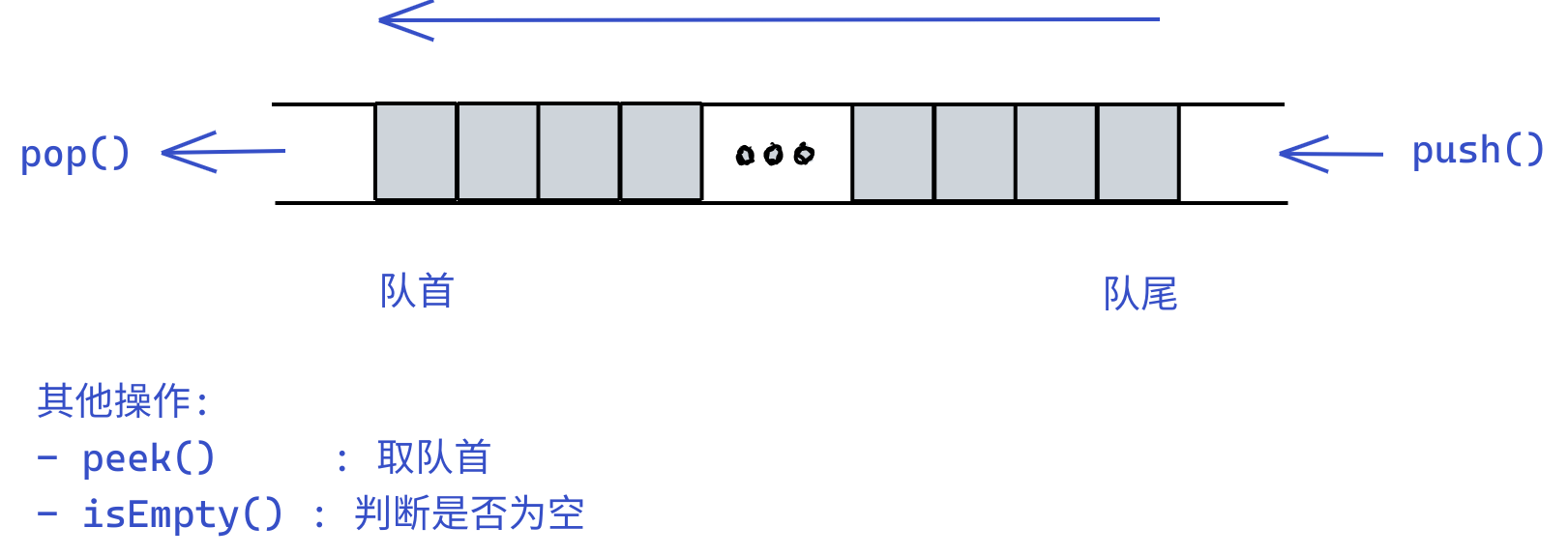栈 Stack

栈 具有 先进后出 特性。有如下几个操作:
push(x): 将x压入栈顶pop(): 删除并返回栈顶元素top(): 返回栈顶元素isEmpty(): 判断是否为空
队列 Queue

队列 具有 先进先出 特性。有如下几个操作:
push(x): 将x压入队尾pop(): 删除并返回队首元素peek(): 返回队首元素isEmpty(): 判断是否为空
LeetCode 题目
232. 用栈实现队列
https://leetcode-cn.com/problems/implement-queue-using-stacks/
题目描述
Note
请你仅使用两个栈实现先入先出队列。队列应当支持一般队列的支持的所有操作(push、pop、peek、empty):
实现 MyQueue 类:
void push(int x)将元素 x 推到队列的末尾int pop()从队列的开头移除并返回元素int peek()返回队列开头的元素boolean empty()如果队列为空,返回true;否则,返回false
说明:
- 你只能使用标准的栈操作 —— 也就是只有
push to top,peek/pop from top,size, 和is empty操作是合法的。 - 你所使用的语言也许不支持栈。你可以使用 list 或者 deque(双端队列)来模拟一个栈,只要是标准的栈操作即可。
进阶:
你能否实现每个操作均摊时间复杂度为 $O(1)$ 的队列?换句话说,执行 $n$ 个操作的总时间复杂度为 $O(n)$ ,即使其中一个操作可能花费较长时间。
提示:
1 <= x <= 9- 最多调用 100 次
push、pop、peek和empty - 假设所有操作都是有效的 (例如,一个空的队列不会调用
pop或者peek操作)
思路
- 用数组 list 实现栈
- 栈与队列的区别:栈作用于栈顶,队列作用于队首
pop()peek()
- 设计
- 用
self.a记录队首(栈底)元素 pop()操作时,主栈self.A需要借助辅助栈self.Bwhile self.A: self.B.append(self.A.pop()) res = self.B.pop() while self.B: self.push(self.B.pop()) return respeek()操作,直接返回self.a
- 用
代码 Python
class MyQueue:
def __init__(self):
"""
Initialize your data structure here.
"""
self.A, self.B = [], []
self.a = None
def push(self, x: int) -> None:
"""
Push element x to the back of queue.
"""
if not self.A: self.a = x
self.A.append(x)
def pop(self) -> int:
"""
Removes the element from in front of queue and returns that element.
"""
while self.A:
self.B.append(self.A.pop())
res = self.B.pop()
while self.B:
self.push(self.B.pop())
return res
def peek(self) -> int:
"""
Get the front element.
"""
return self.a
def empty(self) -> bool:
"""
Returns whether the queue is empty.
"""
return not self.A
225. 用队列实现栈
https://leetcode-cn.com/problems/implement-stack-using-queues/
题目描述
Note
请你仅使用两个队列实现一个后入先出(LIFO)的栈,并支持普通队列的全部四种操作(push、top、pop 和 empty)。
实现 MyStack 类:
void push(int x)将元素x压入栈顶。int pop()移除并返回栈顶元素。int top()返回栈顶元素。boolean empty()如果栈是空的,返回true;否则,返回false。
注意:
- 你只能使用队列的基本操作 —— 也就是
push to back、peek/pop from front、size和is empty这些操作。 - 你所使用的语言也许不支持队列。 你可以使用 list (列表)或者 deque(双端队列)来模拟一个队列 , 只要是标准的队列操作即可。
提示:
1 <= x <= 9- 最多调用100 次
push、pop、top和empty - 每次调用
pop和top都保证栈不为空
进阶: 你能否实现每种操作的均摊时间复杂度为 $O(1)$ 的栈?换句话说,执行 $n$ 个操作的总时间复杂度 $O(n)$ ,尽管其中某个操作可能需要比其他操作更长的时间。你可以使用两个以上的队列。
思路
- 思路类似于 232 用栈实现队列
- 用
self.a记录栈顶(队尾)元素 pop()操作时,主队列 self.A 需要借助辅助队列 self.Bwhile len(self.A) > 1: self.B.append(self.A.popleft()) res = self.A.popleft() while self.B: self.push(self.B.popleft()) return restop()操作时,直接返回self.a
代码 Python
from collections import deque
class MyStack:
def __init__(self):
"""
Initialize your data structure here.
"""
self.A, self.B = deque(), deque()
self.a = None
def push(self, x: int) -> None:
"""
Push element x onto stack.
"""
self.A.append(x)
self.a = x
def pop(self) -> int:
"""
Removes the element on top of the stack and returns that element.
"""
while len(self.A) > 1:
self.B.append(self.A.popleft())
res = self.A.popleft()
while self.B:
self.push(self.B.popleft())
return res
def top(self) -> int:
"""
Get the top element.
"""
return self.a
def empty(self) -> bool:
"""
Returns whether the stack is empty.
"""
return not bool(self.A)